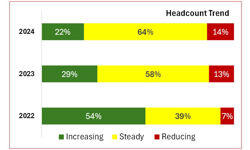According to WAN-IFRA: The report showed that, contrary to conventional wisdom, newspapers remain a large and thriving industry world-wide, despite the impact of the global recession and the rise of digital media.
"Frankly, I have noticed a tendency amongst media journalists and commentators to dwell on the negative aspects of the business when it is clear there is much to be positive about," said Christoph Riess, CEO of WAN-IFRA, who presented the report.
The figures showed:
• 1.7 billion people read a daily newspaper every day, representing 25 percent of the world's adult population. When non-dailies are added, the global reach of newspapers is 37 percent.
• Daily newspaper circulation fell - 0.8 percent in 2009 a small decline, given the depth of the recession, and in comparison with declines in other industries -- but remained up +5.7 percent over five years. Circulation declines largely occurred in mature media markets of the developed world, while Asia continues to enjoy significant growth: up + 1 percent in 2009 and +13 percent over five years.
• A majority of countries 61 percent report stable or increased circulations over one year, and 68 percent report stable or increased circulations over five years.
• The number of newspaper titles world-wide was 12,477 in 2009, an increase of +1.7 percent from a year earlier.
• Global newspaper advertising revenue fell -17 percent in 2009, largely reflecting the global recession's impact on all businesses. But advertising revenues are bouncing back and are expected to increase 3.5 percent in 2010, with growth in all regions, according to forecasts from Zenith Optimedia.
• Television is the world's largest advertising medium with a 39 percent share, followed by newspapers with 24 percent and the internet with 12 percent. Much of internet advertising remains embedded in search, which is controlled by one player Google which takes 65 percent of the market.
Though traditional newspapers in many mature markets have been losing readership, newspaper companies in those markets are in the forefront of the digital revolution, Mr Riess said.
"Many newspaper companies in mature markets have embraced digital platforms and new forms of print publishing, growing their product portfolios, audience reach and revenues, even while their tradittional print circulations have come under pressure," he said.
"In fact, it is this metamorphosis of the printed newspaper business into a dynamic, print based but digitally expansionist new media business model, that is both the problem and the opportunity for our industry," he said.
"The evidence is building that, for many, our print business is facing deep changes. We know of the challenges facing our large metro-based newspapers in developed markets, but we hear less of the changing and expanding printed newspaper market elsewhere, where new products and new newspapers are launched to match the needs of a rapidly evolving and increasingly sophisticated market."
The new data was released to some 400 publishers, editors and other senior newspaper executives from 32 countries attending the annual WAN-IFRA Publish Asia conference in Kuala Lumpur, Malaysia.
The report includes data from all 233 countries and territories where newspapers are published.
The figures showed:
Circulation
• Global paid-for daily newspaper circulation fell -0.8 percent in 2009 from a year earlier, to 517 million copies sold. By region, circulation was up +1 percent in Asia and +4.8 percent in Africa. It fell -3.4 percent in North America, -4.6 percent in South America, -5.6 percent in Europe, and -1.5 percent in Australia and Oceania.
• Over five years, global paid-for daily newspaper circulation rose +5.7 percent. It was up +30 percent in Africa, +13 percent in Asia, +5 percent in South America, and down -10.6 percent in North America, -7.9 percent in Europe, and -5.6 percent in Australia and Oceania.
• When free papers are added, circulation fell -1.7 percent globally, but rose +7.7 percent over five years. Free newspapers now represent 20 percent of all circulation in Europe, 11 percent of South American circulation, 7 percent in North America, and 9 percent in Australia and Oceania.
• The number of daily newspaper titles rose 1.7 percent world-wide in 2009, to 12,477. The number of titles increased +2.7 percent in Asia, +1.3 percent in North America, , +1 percent in South America, +0.2 percent in Africa, and was stable in Europe, Australia and Oceania.
• Global paid-for non-daily newspaper circulation was up +2.5 in 2009 from a year earlier, to 278 million copies sold. By region, non-daily circulation was up +3.1 percent in Asia, +1.8 percent in Australia and Oceania, +1.5 percent in Europe, and was stable in South America. It fell -6.2 percent in Africa and -1.4 percent in North America.
• Over five years, global paid-for non-daily newspaper circulation rose
+15.6 percent. It was up +18.7 percent in Europe, +17.3 percent in Asia and stable in South America. It was down -7.1 percent in North America, -5.1 percent in Australia and Oceania, and -0.1 percent in Africa.
• The five largest markets for newspapers are: India, with 110 million copies sold daily, China, with 109 million sold daily, Japan (50 million), United States (46 million), and Germany (20 million). Sixty-seven of the world's 100 largest daily newspapers are Asian.
Advertising
• Global advertising is forecast to grow +3.5 percent in 2010, according to Zenith Optimedia. Strong growth is forecast for Asia - +5.8 percent, while advertising is forecast to grow +2.2 percent in western Europe and +1.3 percent in North America.
• Global newspaper advertising revenues fell -17 percent in 2009; North American newspapers lost a quarter of their advertising revenues. Ad spend was also down in Western Europe -13.7 percent, Central and Eastern Europe -18.7 percent, Asia 9.6 percent, Latin America -2.9 percent and was stable in the Middle East and Africa.
• Over five years, global advertising revenues fell -17.9 percent. It was down one-third in North America, -15 percent in western Europe and -5.4 percent in Asia. It rose +46.5 percent in Latin America, +1.1 percent in central and eastern Europe, and was stable in the Middle East and Africa.
• There is a growing body of evidence that shows print advertising is more effective than either television or internet advertising. A recent study in the United Kingdom by Microsoft indicates that every pound spent on print advertising yields 5 pounds in revenue. This compares with returns of 2.2 pounds for television and 3.4 pounds for online advertising.
Online
• At no time in the foreseeable future will digital advertising revenues replace those lost to print, making the search for new business models including paid-for online access for news a key goal for many newspapers.
• Mobile news delivery appears to hold more promise for newspapers than traditional internet delivery: there is 100 penetration across demographics; mobile content payment is well established. But there are drawbacks as well: an advertising model has yet to emerge; and those who control the channels have, as yet, shown little interest in content and partnerships.
• Digital readers also show promise, but must overcome problems of readability and the need for powerful batteries, which are expected to be heavy and polluting for the foreseeable future.
The World Press Trends 2010 edition is now available at http://www.wan-press.org/worldpresstrends2010/home.php
In addition to much more data, country by country, the 1,230-page publication includes information on:
• Non-daily publications, which in some markets are performing better than dailies;
• Advertising expenditure forecasts for newspapers and magazines, together with total spending forecasts, for 2010, 2011 and 2012;
• Trends in format and cover price of daily newspapers; in colour capability; in media consumption, in display and classified advertising income, in distribution of sales between single copy and subscription;
• Data on the top-selling titles in each country, the top sectors for advertising in newspapers and the major advertisers;
• Information on the tax rates and conditions for the press, on subsidies, on ownership regulations, and more.










